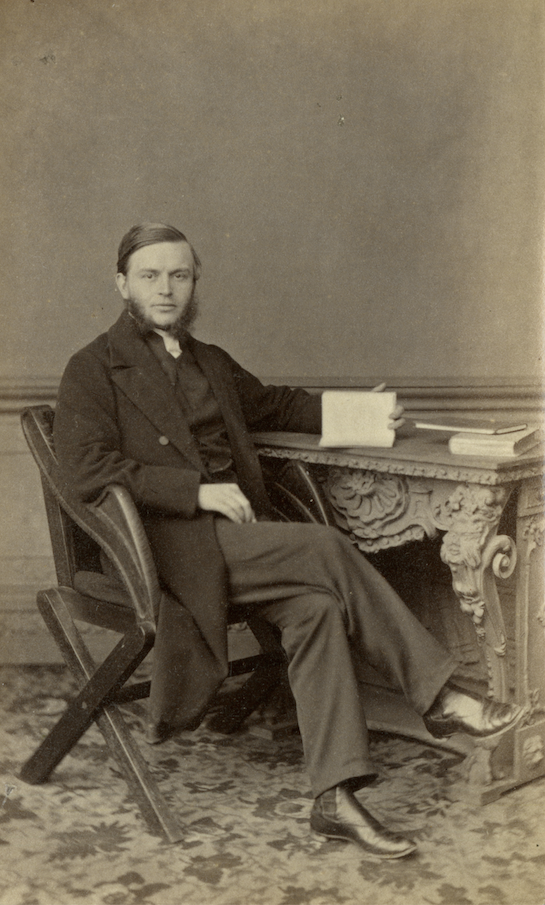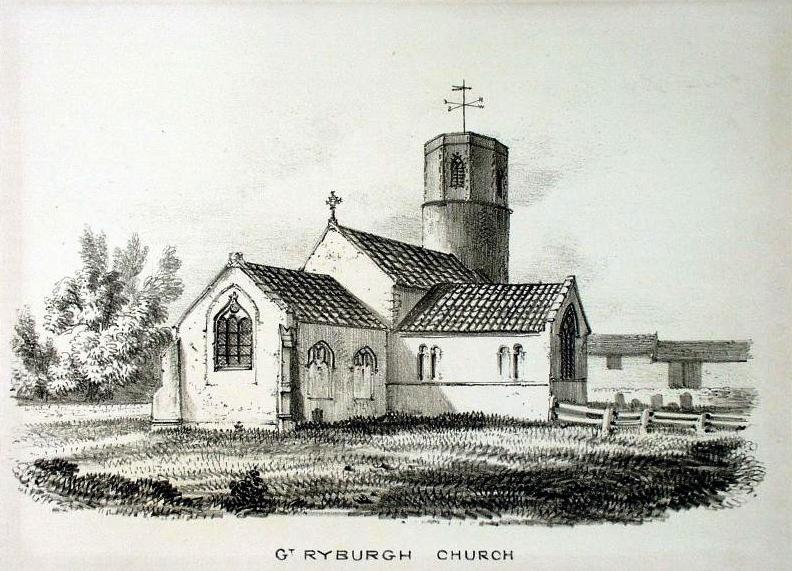An account of the restoration of the church transcribed from an unidentified
press cutting of 1860 pasted into the Preacher's Book of Rev.G.E.Tatham
(N.R.O. PD 621/23)


Image of George Tatham by Mason & Co Norwich and London c 1865
copyright Picture Norfolk
“Happy are the people that are in such a case.”
The Church of St. Andrew, Great Ryburgh, is one of the few specimens of a perfect cruciform church in the county of Norfolk; it consists of a chancel, nave, and north and south transept of nearly equal length. The structure is of the fifteenth century, with the exception of the western tower, which is of the latest Saxon period; and, until recently was defaced with plastered ceilings, square piers 1 and the usual coverings of whitewash. The original font was found buried in the ground, and formed the basement of the modern basin. Ten of the windows had also been entirely blocked up, so that little or no trace of them could be seen: and the ancient east window had been replaced with a wooden one of ogre2 form.
All these defects have now been removed, most of the 3 windows opened, a new east window constructed with a trefoil gable light above; the ceilings have been replaced by the open ancient roofs in character with the building, relieved by the introduction of colour throughout; the old work having been preserved wherever it was practicable. That portion of the roof which covers the sacrarium has been painted azure, with gilt stars and vermillion mouldings round the panels; whilst the remainder of the chancel roof has been cladded and painted azure between the spars. The sacrarium itself, consisting of two raised spaces and footpace has been paved with Minton tiles, laid within York stone borderings, and is divided from the rest of the chancel by an oak rail, supported on Hart’s iron standards, coloured blue and chocolate with gilt foliage, producing a light and pleasing effect. The church has been re-seated throughout with open benches, nearly doubling the previous accommodation, though an unsightly western gallery has been removed; and although much yet remains to be completed, it was in a fit state for the recommencement of divine worship, and was reopened on Friday, July 20th, when two full services were celebrated –in the morning at eleven o’clock (with Holy Communion), and in the evening at four o’clock, the Lord Bishop of the diocese officiating at the Holy Communion and preaching at both services. The prayers were said on both occasions by the Rev. G.E.Tatham, rector of the parish; the Revs. C. St. Denys Moxon 4 and J.B. Sweet 5 being the readers of the morning Lessons; and the former gentleman and the Rev. A.B. Hemsworth (lately curate of the parish) reading the afternoon Lessons. The Hon. and Rev. Canon Digby and the Rev. Canon Greene, Rural Deans, assisted the Bishop and the Rector at the Holy Communion. The Canticles, Psalms for the day, anthems, &c., were sung by the choir of the church, assisted by two or three friends, the congregation joining most heartily; and the “Amens” throughout the services were sung with great effect and solemnity. Ninety-one persons partook of the Lord’s Supper, and above 600 persons were present at the evening service. The Offertories amounted to £34. 0s. 11/2d., and are to be devoted to the restoration fund, [AD1860 in ink by G.E.T]
1 amended in ink by G.E.T. to pews
2 amended in ink by G.E.T. to ogee
3 amended in ink by G.E.T. to all the
4 Hempton
5 Colkirk
It is quite likely that George Tatham supplied the original copy text . The emendations were possibly made after the insertion of the Smith memorial windows (mid 1870's) in the North and South Transepts. These replaced the Norman window openings seen here on Robert Ladbrooke's lithograph of the Church c1830 about 20 years before George's arrival in Ryburgh.

Since this page was created, a search of the British Newspaper Archive has found a very similar report in the Norfolk Chronicle on July 20th 1860 and which gives a little more detail. This and the following clippings are reproduced by coutesty of the British Newspaper Archive:

Much of the restoration was funded by the Tatham family but further related cuttings show that donations also came from charitable trusts as seen in the Morning Post June 22nd 1860:

and the Norfolk Chronicle on October 20th 1860:



Images of this restoration seem to have survived in but one photograph, issued as a postcard in the first decade of the 20th Century and you can read here more about surviving features from this period:

Recent oral history tells of the discovery of the William Wailes East Window in the Rectory basement before the sale of the property, only to disappear before it could be rescued! It must have lain there since 1911 when the Comper window was installed
It is described below in the entry in Kelly's Directory of 1879 with further information probably supplied by George Tatham:




copyright 2022